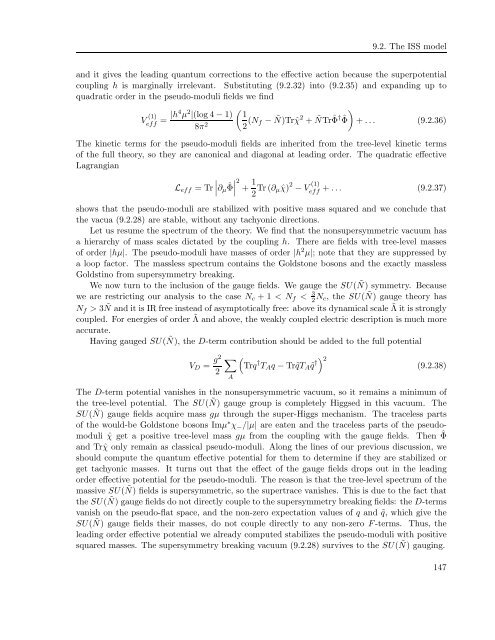Perturbative and non-perturbative infrared behavior of ...
Perturbative and non-perturbative infrared behavior of ...
Perturbative and non-perturbative infrared behavior of ...
You also want an ePaper? Increase the reach of your titles
YUMPU automatically turns print PDFs into web optimized ePapers that Google loves.
9.2. The ISS model<br />
<strong>and</strong> it gives the leading quantum corrections to the effective action because the superpotential<br />
coupling h is marginally irrelevant. Substituting (9.2.32) into (9.2.35) <strong>and</strong> exp<strong>and</strong>ing up to<br />
quadratic order in the pseudo-moduli fields we find<br />
V (1)<br />
eff = |h4 µ 2 |(log 4 − 1)<br />
8π 2<br />
1<br />
2 (Nf − Ñ)Trˆχ2 + ÑTrˆ Φ †ˆ Φ<br />
<br />
+ ... (9.2.36)<br />
The kinetic terms for the pseudo-moduli fields are inherited from the tree-level kinetic terms<br />
<strong>of</strong> the full theory, so they are ca<strong>non</strong>ical <strong>and</strong> diagonal at leading order. The quadratic effective<br />
Lagrangian<br />
<br />
<br />
Leff = Tr ∂µ ˆ <br />
<br />
Φ<br />
2<br />
+ 1<br />
2 Tr (∂µ ˆχ) 2 − V (1)<br />
eff + ... (9.2.37)<br />
shows that the pseudo-moduli are stabilized with positive mass squared <strong>and</strong> we conclude that<br />
the vacua (9.2.28) are stable, without any tachyonic directions.<br />
Let us resume the spectrum <strong>of</strong> the theory. We find that the <strong>non</strong>supersymmetric vacuum has<br />
a hierarchy <strong>of</strong> mass scales dictated by the coupling h. There are fields with tree-level masses<br />
<strong>of</strong> order |hµ|. The pseudo-moduli have masses <strong>of</strong> order |h2 µ|; note that they are suppressed by<br />
a loop factor. The massless spectrum contains the Goldstone bosons <strong>and</strong> the exactly massless<br />
Goldstino from supersymmetry breaking.<br />
We now turn to the inclusion <strong>of</strong> the gauge fields. We gauge the SU( Ñ) symmetry. Because<br />
we are restricting our analysis to the case Nc + 1 < Nf < 3<br />
2Nc, the SU( Ñ) gauge theory has<br />
Nf > 3Ñ <strong>and</strong> it is IR free instead <strong>of</strong> asymptotically free: above its dynamical scale ˜ Λ it is strongly<br />
coupled. For energies <strong>of</strong> order ˜ Λ <strong>and</strong> above, the weakly coupled electric description is much more<br />
accurate.<br />
Having gauged SU( Ñ), the D-term contribution should be added to the full potential<br />
VD = g2<br />
2<br />
<br />
A<br />
<br />
Trq † TAq − Tr˜qTA˜q † 2<br />
(9.2.38)<br />
The D-term potential vanishes in the <strong>non</strong>supersymmetric vacuum, so it remains a minimum <strong>of</strong><br />
the tree-level potential. The SU( Ñ) gauge group is completely Higgsed in this vacuum. The<br />
SU( Ñ) gauge fields acquire mass gµ through the super-Higgs mechanism. The traceless parts<br />
<strong>of</strong> the would-be Goldstone bosons Imµ ∗χ−/|µ| are eaten <strong>and</strong> the traceless parts <strong>of</strong> the pseudomoduli<br />
ˆχ get a positive tree-level mass gµ from the coupling with the gauge fields. Then ˆ Φ<br />
<strong>and</strong> Trˆχ only remain as classical pseudo-moduli. Along the lines <strong>of</strong> our previous discussion, we<br />
should compute the quantum effective potential for them to determine if they are stabilized or<br />
get tachyonic masses. It turns out that the effect <strong>of</strong> the gauge fields drops out in the leading<br />
order effective potential for the pseudo-moduli. The reason is that the tree-level spectrum <strong>of</strong> the<br />
massive SU( Ñ) fields is supersymmetric, so the supertrace vanishes. This is due to the fact that<br />
the SU( Ñ) gauge fields do not directly couple to the supersymmetry breaking fields: the D-terms<br />
vanish on the pseudo-flat space, <strong>and</strong> the <strong>non</strong>-zero expectation values <strong>of</strong> q <strong>and</strong> ˜q, which give the<br />
SU( Ñ) gauge fields their masses, do not couple directly to any <strong>non</strong>-zero F-terms. Thus, the<br />
leading order effective potential we already computed stabilizes the pseudo-moduli with positive<br />
squared masses. The supersymmetry breaking vacuum (9.2.28) survives to the SU( Ñ) gauging.<br />
147
















